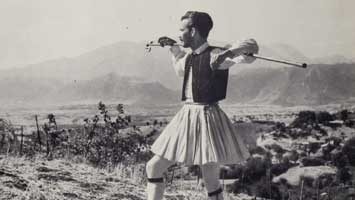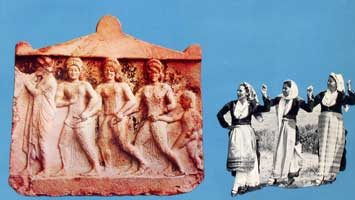“Musical Travelogue with Domna Samiou” (“Musiko Odiporiko me ti Domna Samiou”) was a television series researched and presented by Domna Samiou and broadcast by Greek National Television in 1976-1977. Each episode was dedicated to the music and dance tradition of a different area of Greece.

In the small village of Tzitzifia, Domna Samiou meets Christos Tsigkounakis, a farmer and a peddler who sings a Mandinada. (improvised couplets which are sung in Crete) and the song of Yannis and the Sun. He also explains the meaning of this song and recounts his experiences as a foreign worker in West Germany during the years 1965 to 67.
I crave sitting on high places
for my heart is sad and I cannot endure it
Mandinada
Christos Tsigkounakis. Tzitzifia Chania 1976
TV program “Musical Travelogue with Domna Samiou”
Yannis and the Sun
Christos Tsigkounakis. Tzitzifia Chania 1976
TV program “Musical Travelogue with Domna Samiou”
Discussion with Christos Tsigkounakis
Christos Tsigkounakis. Tzitzifia, Chania 1976
TV program “Musical Travelogue with Domna Samiou”

In Chania, Domna meets the musician Nikos Koliakoudakis or Koliakoudis, originally from the region of Apokoronas, who plays his lute and sings the slow table song Whoever Loves Is Evident. Domna joins him to sing the famous song Black Clothes.
Whoever Loves Is Evident
Nikos Koliakoudakis, Cretan lyra and song. Chania 1976
TV program “Musical Travelogue with Domna Samiou”
Black Clothes
Domna Samiou, song, Nikos Koliakoudakis, Cretan lyra. Chania 1976
TV program “Musical Travelogue with Domna Samiou”
Black clothes are as heavy as chains
For I wore them because of a love I had

In the village of Kambanos a group of men sitting around the table sing Mandinades and Rizitika songs. Rizitika are sung by men and are the oldest type of Cretan folk songs. They originate in areas at the foot (rizes) of mountains. Usually, the first singer sings a verse and it is repeated chorally by the group.
Rizitika 1
Group of Men. Kambanos, Chania 1976
TV program “Musical Travelogue with Domna Samiou”
Rizitika 2
Group of Men. Kambanos, Chania 1976
TV program “Musical Travelogue with Domna Samiou”
Mandinada
Group of Men. Kambanos, Chania 1976
TV program “Musical Travelogue with Domna Samiou”

Giorgis Tsirintanis in Anopoli, Sfakia sings the historical Song of Daskaloyannis.
The Song of Daskaloyannis
Giorgis Tsirintanis. Anopoli, Sfakia 1976
TV program “Musical Travelogue with Domna Samiou”

In Askifou, Sfakia a group of men dances the local Pendozali Dance.
Pentozali Dance
Cretan lyra, lute. Askifou, Skakia 1976
TV program “Musical Travelogue with Domna Samiou”

In a café in Chania, a group dances the Syrtos Dance of Chania. Ross Daly plays the Cretan lyra and Stelios Sergakis plays the lute.
Syrtos Dance of Chania
Ross Daily, Cretan lyra, Stelios Sergakis, lute. Chania 1976
TV program “Musical Travelogue with Domna Samiou”

In the courtyard of a High School in Chania a group of girls dance Siganos and Pentozalis dances. Aspasia Papadaki plays the Cretan lyra. Aspasia is the first woman lyra player in Crete. Domna Samiou had recorded Aspasia in 1965 and included two of her recordings in the album Ethnologie Vivante: Grèce which was released in 1970 in France.
Siganos & Pentozali Dance
Aspasia Papadaki, Cretan lyra. Chania 1976
TV program “Musical Travelogue with Domna Samiou”
The episode ends with the historical Song of Liapis, sung acapella by Zambia Varda and Yannis Lathiotakis.
The Song of Liapis
Zambia Varda, Yannis Lathiotakis. Kroustas Lassithi 1976
TV program “Musical Travelogue with Domna Samiou”
Credits
Research and presentation: Domna Samiou
Director: Fotos Labrinos
Director of photography: Syrakos Danalis
Sound engineer: Dimitris Georgiou




